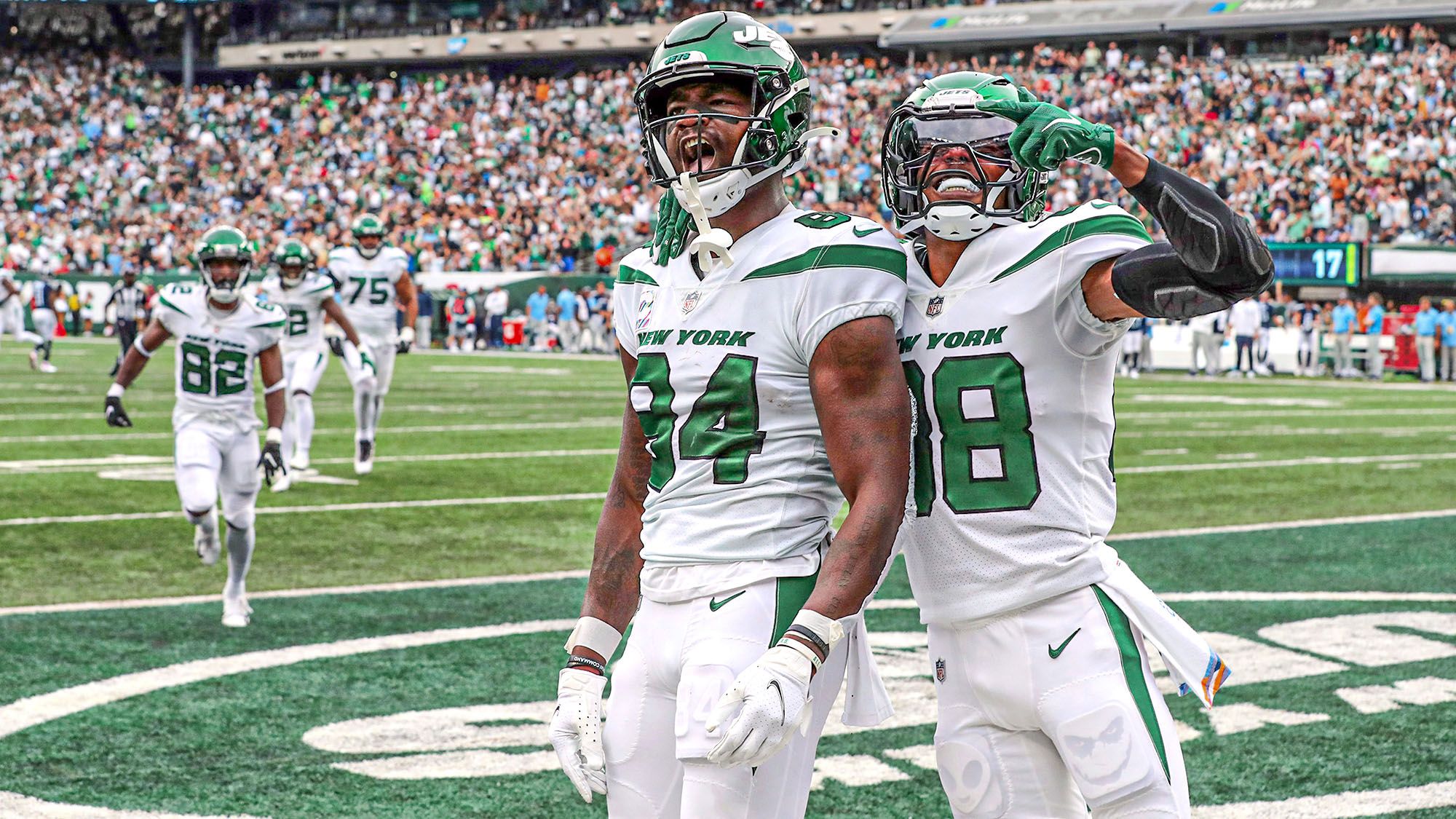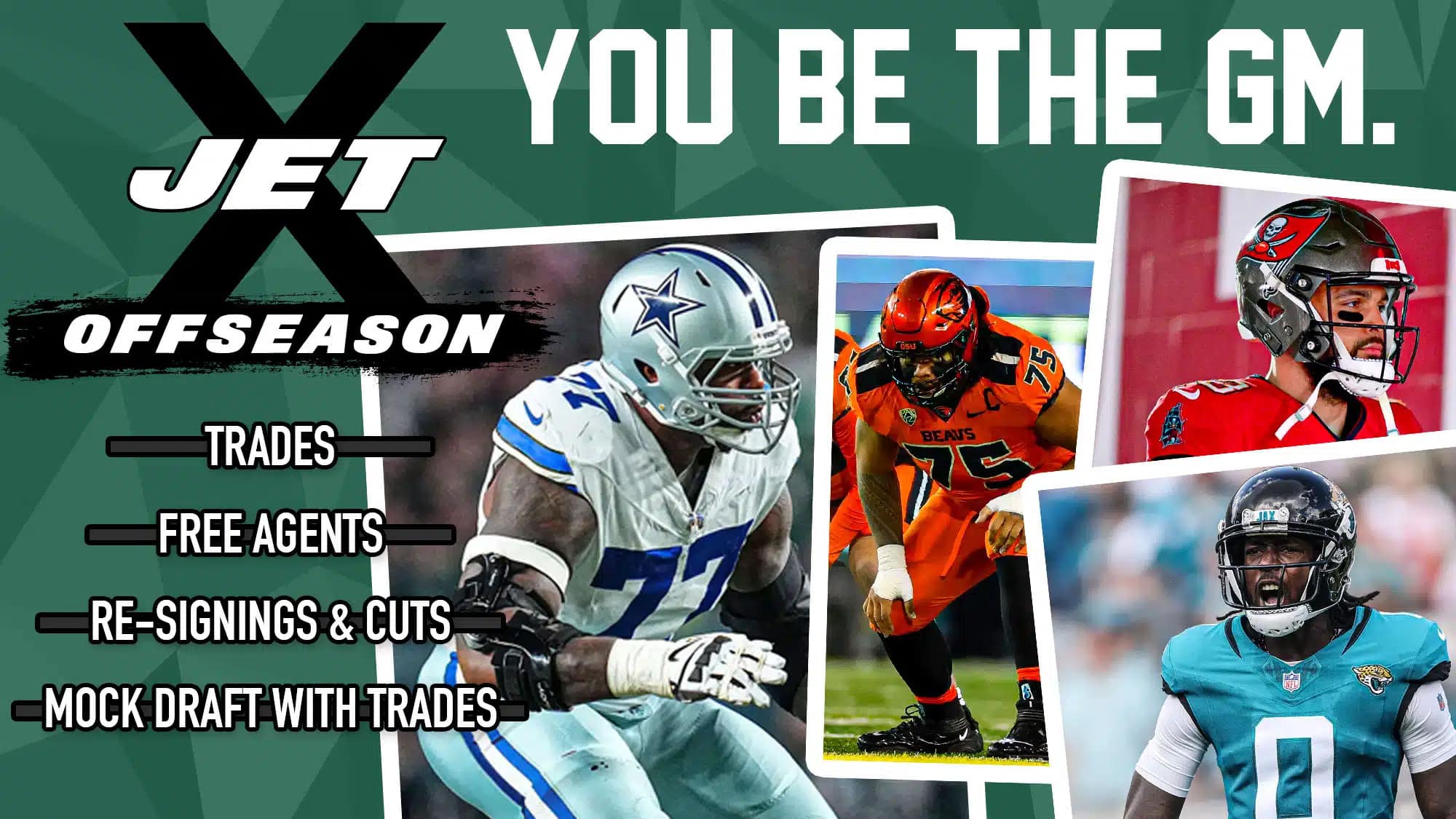Where did each New York Jets unit rank leaguewide in 2021?
Coming up with definitive rankings for NFL players is an impossible task. There is no single statistic nor agglomeration of statistics that can be considered an inarguable end-all-be-all for ranking players.
With that being said, Pro Football Focus‘ grading system is probably our closest shot at being able to pull off such an endeavor. While PFF’s grades are subjective and thus imperfect, they do provide us with a one-number score for all players that allows us to compare them against one another on the same scale.
On that note: Where did the New York Jets rank across the NFL at every position in 2021?
I took the overall offensive or defensive PFF grade for every NFL player who appeared in the 2021 regular season and weighted their grade according to the number of offensive or defensive snaps they played. Then, I calculated each team’s cumulative PFF grade among all of their players at each position in order to rank all 32 units around the league at every position.
Let’s take a look at how the Jets fared, ranking their 10 position groups from worst to best based on how each position’s overall PFF grade compared to the league average.
10. Quarterback
- NFL average QB unit grade: 72.6
- Jets QB unit grade: 58.3 (29th of 32)
- Jets margin vs. NFL average: -14.3
Zach Wilson showed great progress near the end of his rookie season, but his overall body of work in 2021 was still poor when you take the rookie curve out of the equation.
However, Wilson was not the worst quarterback in the league by PFF’s standards. Wilson earned an overall grade of 59.3 at PFF, ranking 34th out of 39 qualified passers. That placed him ahead of Tyrod Taylor, Davis Mills, Ben Roethlisberger, Sam Darnold, and Mike Glennon.
Mike White did not play enough reps to qualify for the aforementioned group but his 53.6 grade would have been second-worst ahead of only Glennon. Joe Flacco’s 62.1 grade would have ranked 31st.
9. Linebacker
- NFL average LB unit grade: 55.2
- Jets LB unit grade: 41.7 (30th of 32)
- Jets margin vs. NFL average: -13.5
PFF did not like C.J. Mosley’s performance this season at all, ranking him 52nd out of 60 qualified linebackers with a 40.9 grade. I think that’s much too harsh in my personal opinion – I felt like he was solid – but it’s certainly worth noting that Mosley earned such a poor grade.
Quincy Williams did not fare much better, placing 43rd with a 44.6 overall grade.
Somehow, the Jets’ backups managed to perform even worse than Mosley and Williams. Del’Shawn Phillips, Blake Cashman, Jarrad Davis, and Hamsah Nasirildeen all earned worse grades than Mosley and Williams.
Jamien Sherwood was actually the Jets’ highest-graded linebacker with an above-average grade of 59.7.
8. Cornerback
- NFL average CB unit grade: 63.6
- Jets CB unit grade: 55.5 (31st of 32)
- Jets margin vs. NFL average: -8.1
Bryce Hall led the cornerback group with a grade of 63.3 that was right around average. His 64.5 coverage grade was above-average for the position but Hall faltered in the run game, damaging his overall grade a tad.
Javelin Guidry (55.9), Isaiah Dunn (54.8), Michael Carter II (53.7), and Brandin Echols (45.0) followed Hall with substantially below-average grades.
7. Tight end
- NFL average TE unit grade: 64.4
- Jets TE unit grade: 57.6 (30th of 32)
- Jets margin vs. NFL average: -6.8
Five tight ends played for the Jets this year (Tyler Kroft, Ryan Griffin, Trevon Wesco, Kenny Yeboah, Daniel Brown) and none of them reached the league-average tight end grade of 64.4.
6. Interior defensive line
- NFL average IDL unit grade: 60.3
- Jets IDL unit grade: 55.0 (25th of 32)
- Jets margin vs. NFL average: -5.3
Quinnen Williams led the Jets with a slightly above-average grade of 64.4, although his raw production was much more impressive than that.
Foley Fatukasi was barely above-average at 61.5. This unit was dragged down by the rough seasons of Nathan Shepherd (50.8) and Sheldon Rankins (46.1), who particularly struggled against the run.
5. Safety
- NFL average S unit grade: 65.6
- Jets S unit grade: 60.4 (27th of 32)
- Jets margin vs. NFL average: -5.2
I think PFF oversold this unit quite a bit, but even so, it was still a bottom-six group.
Jason Pinnock led the way with a 70.4 grade, which put him at the 69th percentile among qualified safeties this season. I thought Pinnock held up respectably well after getting thrown into the fray at safety late in the year, but on a few plays where he could be seen forcing an incompletion on TV, he was actually beat in coverage but benefited from a bad/late throw. You can see a couple of those plays near the end of this Blewett’s Blitz film review.
Ashtyn Davis (60.7), Elijah Riley (58.1), Marcus Maye (55.9), and Sharrod Neasman (53.8) were all below-average. It could be argued Davis was worse than that – his grade ballooned thanks to a few forced fumbles and interceptions despite overall inconsistency.
4. Running back
- NFL average RB unit grade: 69.4
- Jets RB unit grade: 65.1 (25th of 32)
- Jets margin vs. NFL average: -4.3
Michael Carter had a good year. His 71.0 overall grade ranked 22nd out of the 50 running backs with at least 100 carries. That grade was dragged down by Carter’s passing-game woes with drops and pass protection, but as a pure rusher, he was even better. His rushing grade of 77.3 ranked 18th.
This unit is bogged down by Ty Johnson, who was a mediocre rusher and terrible passing-game performer. Johnson’s 56.0 overall grade ranked third-worst out of the 77 running backs with at least 50 carries.
Thanks to his cleaner play in the passing game, Tevin Coleman actually earned a better overall grade than Carter despite having a lower rushing grade. Coleman’s 73.7 overall grade ranked 26th out of 77 (Carter ranked 33rd in that bunch).
3. Wide receiver
- NFL average WR unit grade: 68.7
- Jets WR unit grade: 64.7 (27th of 32)
- Jets margin vs. NFL average: -4.0
The Jets got respectable performances from their go-to wide receivers. Braxton Berrios (74.0 grade) and Elijah Moore (71.2) had above-average grades that ranked 34th and 47th, respectively, out of 138 qualified wide receivers. Corey Davis’ 68.8 grade was just a hair above the positional average.
Outside of that trio, everyone struggled. Jamison Crowder (64.9), Keelan Cole (61.3), Jeff Smith (57.9), and Denzel Mims (48.7) ranked 84th, 100th, 113th, and 137th, respectively, out of 138 qualifiers.
Play: 👉 the Jet X Offseason Simulator
2. Edge defender
- NFL average EDGE unit grade: 66.0
- Jets EDGE unit grade: 66.3 (15th of 32)
- Jets margin vs. NFL average: +0.3
A strong season from John Franklin-Myers powers this ranking. Franklin-Myers’ 80.3 grade – the best on the team by any offensive or defensive player – ranked 11th out of 61 qualified edge defenders.
Every other edge defender on the Jets’ roster had a grade below the positional average.
1. Offensive line
- NFL average OL unit grade: 67.7
- Jets OL unit grade: 69.4 (12th of 32)
- Jets margin vs. NFL average: +1.7
The Jets’ only legitimately good unit by PFF’s standards was the offensive line. Connor McGovern (75.9 grade), George Fant (71.2), and Morgan Moses (71.0) led the way for a unit that held up impressively after the opening-week loss of Mekhi Becton.
No area where Jets cannot improve
I don’t make PFF grades – I’m just the messenger. Value them however you like.
Regardless of however many disagreements we may have with some of PFF’s conclusions, one thing becomes clear from the numbers above: The Jets can improve significantly at every single position on the football field.


